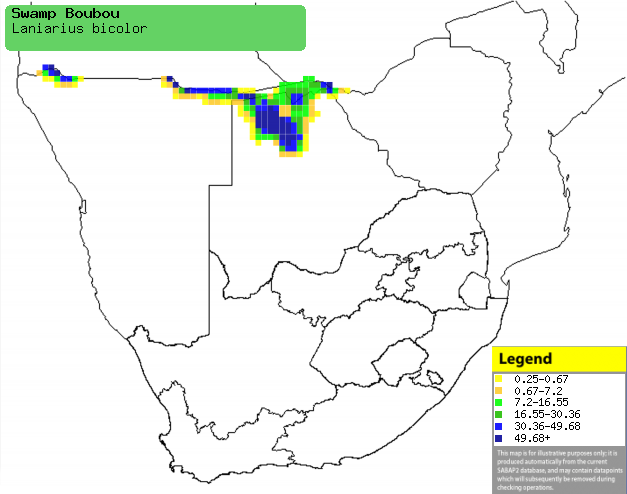|
Laniarius bicolor (Swamp
boubou)
Moeraswaterfiskaal [Afrikaans]; Nankuwo (generic term
for boubou) [Kwangali]; Moerasfiskaal [Dutch]; Gonolek à ventre blanc [French];
Zweifarbenwürger [German]; Picanço-dos-pântanos [Portuguese]
Life
> Eukaryotes >
Opisthokonta
> Metazoa (animals) >
Bilateria >
Deuterostomia > Chordata >
Craniata > Vertebrata (vertebrates) > Gnathostomata (jawed
vertebrates) > Teleostomi (teleost fish) > Osteichthyes (bony fish) > Class:
Sarcopterygii (lobe-finned
fish) > Stegocephalia (terrestrial
vertebrates) > Tetrapoda
(four-legged vertebrates) > Reptiliomorpha > Amniota >
Reptilia (reptiles) >
Romeriida > Diapsida > Archosauromorpha > Archosauria >
Dinosauria
(dinosaurs) > Saurischia > Theropoda (bipedal predatory dinosaurs) >
Coelurosauria > Maniraptora > Aves
(birds) >
Order: Passeriformes
> Family: Malaconotidae
Distribution and habitat
Occurs from Cameroon and the DRC to southern Africa, where
it is locally common in northern Botswana, the Caprivi Strip and the upper-most
reaches of Namibia. It almost only occurs along watercourses with surrounding
dense vegetetation, such as tall reedbeds, Cyperus papyrus (Papyrus) and
Ficus verruculosa (Water figs).
|
 |
|
Distribution of Swamp boubou in southern Africa,
based on statistical smoothing of the records from first SA Bird Atlas
Project (©
Animal Demography unit, University of
Cape Town; smoothing by Birgit Erni and Francesca Little). Colours range
from dark blue (most common) through to yellow (least common). |
Food
It eats a variety of insects, fruit and rarely frogs, doing
most of its foraging in reedbeds or trees, gleaning prey from the vegetation. It
also forages on the ground, flicking plant detritus around with its bill in a
manner similar to thrushes (Muscicapidae).
Breeding
- The nest is a shallow cup of woven twigs and rootlets, usually placed in
small thicket or bush about 2-3 metres above ground.
- Egg-laying season is almost year round, usually peaking around November.
- It lays about 2 eggs which are incubated by both sexes, singing a duet
whenever they change shifts.
Threats
Not threatened.
References
-
Hockey PAR, Dean WRJ and Ryan PG 2005. Roberts
- Birds of southern Africa, VIIth ed. The Trustees of the John Voelcker
Bird Book Fund, Cape Town.
|
